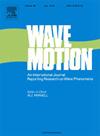非均匀弦和均匀膜非线性和线性振动的波动方程和能量平衡
IF 2.1
3区 物理与天体物理
Q2 ACOUSTICS
引用次数: 0
摘要
考虑了(i)弹性弦和(ii)膜在各向同性张力作用下横向振动的能量通量、能量密度和波动方程。在(i)和(ii)两种情况下,对于(a)具有大斜率的非线性振动和(b)质量密度和切向张力的任意位置和时间函数,通常可以获得含外力的波动方程。对于(a)非线性振动和(c)独立于时间和位置的任意函数的质量密度和切向张力,存在包括能量密度、通量和外力功率的能量方程。在最简单的情况下,均匀弹性(i)弦和(ii)膜的线性振动被考虑为驻模和传播波,证实了传播波的经典结果:(a)动能和弹性能量的均分;(b)能量速度,即能量通量与密度之比,等于波速。表述(a)和(b)一般不成立:(i)对于非均匀弦中的线性波,由于波被非均匀波速折射;(ii)对于均匀弦中的非线性波,因为动能(弹性)能量作为速度(应变)的函数的对比是二次的(具有高阶项);(iii)对于非均匀弦中的非线性波,因为在(i)和(ii)中,速度和应变满足不同的波动方程。本文章由计算机程序翻译,如有差异,请以英文原文为准。
On wave equations and energy balance for non-linear and linear vibrations of non-uniform and uniform strings and membranes
The energy flux, the energy density and the wave equation are considered for the transverse vibrations of (i) elastic strings and (ii) membranes under isotropic tension. In both cases (i) and (ii) the wave equation with external forces is obtained in general for (a) non-linear vibrations with large slope and (b) mass density and tangential tension arbitrary functions of position and time. The energy equation, including the energy density and flux and power of external forces, exists for (a) non-linear vibrations and (c) mass density and tangential tension independent of time and arbitrary functions of position. In the simplest case of linear vibrations of uniform elastic (i) strings and (ii) membranes are considered for standing modes and propagating waves, confirming the classical results for propagating waves: (a) the equipartition of kinetic and elastic energies; (b) the energy velocity, that is the ratio of energy flux and density, equal to the wave speed. The statements (a) and (b) generally do not hold: (i) for linear waves in non-uniform strings due to wave refraction by the non-uniform wave speed; (ii) for non-linear waves in a uniform string because of the contrast between the kinetic (elastic) energy as a function of velocity (strain) that is quadratic (has higher order terms); (iii) for non-linear waves in non-uniform strings because, as in (i) and (ii) the velocity and strain satisfy different wave equations.
求助全文
通过发布文献求助,成功后即可免费获取论文全文。
去求助
来源期刊

Wave Motion
物理-力学
CiteScore
4.10
自引率
8.30%
发文量
118
审稿时长
3 months
期刊介绍:
Wave Motion is devoted to the cross fertilization of ideas, and to stimulating interaction between workers in various research areas in which wave propagation phenomena play a dominant role. The description and analysis of wave propagation phenomena provides a unifying thread connecting diverse areas of engineering and the physical sciences such as acoustics, optics, geophysics, seismology, electromagnetic theory, solid and fluid mechanics.
The journal publishes papers on analytical, numerical and experimental methods. Papers that address fundamentally new topics in wave phenomena or develop wave propagation methods for solving direct and inverse problems are of interest to the journal.
 求助内容:
求助内容: 应助结果提醒方式:
应助结果提醒方式:


